the 2007 Abstract Presentations - Wound Healing Society
the 2007 Abstract Presentations - Wound Healing Society
the 2007 Abstract Presentations - Wound Healing Society
You also want an ePaper? Increase the reach of your titles
YUMPU automatically turns print PDFs into web optimized ePapers that Google loves.
<strong>Abstract</strong>s<br />
71<br />
RADIATION IS A KEY REGULATOR OF ANGIOGENIC AND<br />
ANGIOSTATIC CXC CHEMOKINE EXPRESSION IN HUMAN<br />
ENDOTHELIAL CELLS<br />
Chang C.C., Lerman O.Z., Thanik V.D., Scharf C.L., Warren S.M., Levine<br />
J.P.<br />
Institute of Reconstructive Plastic Surgery, NYU School of Medicine<br />
Introduction: Neovascularization in wound healing requires complex signaling<br />
involving angiogenic and angiostatic chemokines in <strong>the</strong> CXC family. Increasing<br />
evidence suggests that low-dose ionizing radiation (XRT) may be aprovasculogenic<br />
stimulus. However, because radiation is also known to cause tissue<br />
damage, hypovascularity, and impaired wound healing, <strong>the</strong> mechanism of<br />
angiogenic stimulation must be clarified. Compared to pathologic doses of<br />
radiation, we hypo<strong>the</strong>size that low dose radiation induces proangiogenicpatterns<br />
of CXC chemokine signaling in human vascular endo<strong>the</strong>lial cells.<br />
Methods: HUVECs were exposed to 0 Gy, 5 Gy, or 20 Gy ionizing radiation.<br />
Cells were grown in basal media for 24–48 hrs. Total cell protein lysate<br />
washarvested and cytokine expression was analyzed by antibody array.<br />
Candidatecytokine upregulation was <strong>the</strong>n confirmed by quantitative real time<br />
RT-PCR and ELISA. Annexin V and CXC chemokine receptor profiles were<br />
analyzed using flow cytometry.<br />
Results: All proangiogenic chemokines CXCL1-CXCL8 demonstrated doseresponse<br />
induction up to 3- and 13-fold when exposed to 5 Gy and 20 Gy<br />
irradiation, respectively. IFNg and TNF-b were upregulated at 20 Gy by 1.5<br />
fold and 3-fold, respectively. 20 Gy XRT also led to increased angiostatic CXC<br />
chemokine production. Annexin-V assay demonstrated decreased apoptosisfrom<br />
0 Gy–5 Gy XRT (16% vs. 4.5%), however 20 Gy XRT showed increased<br />
annexin-V (24%). CXCR4 expression showed a dose-response relationship<br />
tohypoxia, which was independently augmented by 8- and 16-fold 24 and 48 hrs<br />
after radiation.<br />
Conclusion: XRT induces a dose dependent upregulation of angiogenic members<br />
of <strong>the</strong> CXC family of chemokines in HUVECs. Fur<strong>the</strong>rmore, we observed<br />
induction of inflammatory signals and <strong>the</strong>ir respective angiostatic CXC<br />
chemokines at 20 Gy. This suggests that XRT induces an angiogenic response<br />
at low doses while proinflammatory and apoptotic effects at highdoses result in<br />
tissue damage. Elucidation of <strong>the</strong> mechanism by which CXC chemokine<br />
expression is balanced in response to XRT may reveal novel targetsfor<br />
<strong>the</strong>rapeutic intervention.<br />
73<br />
STROMAL PROGENITOR CELLS (SPC) CORRECT THE<br />
WOUND DEFECT IN MMP-9 KNOCKOUT MICE BY<br />
ENHANCED REEPITHELIALIZATION NOT GRANULATION<br />
TISSUE PRODUCTION<br />
A.T. Badillo, S. Chung, R.A. Redden, L. Zhang, E.J. Doolin, and<br />
K.W. Liechty<br />
Children’s Hospital of Philadelphia, Philadelphia, PA<br />
MMP-9 knockout (MMP-9KO) mice exhibit local impairments in wound<br />
healing as well as impaired progenitor cell release from bone marrow. We have<br />
previously shown that application of SPC to murine diabetic wounds can<br />
improve diabetic wound healing through a combination of direct and indirect<br />
mechanisms. Based on <strong>the</strong>se observations we hypo<strong>the</strong>size that direct application<br />
of SPC to MMP-9KO wounds can both restore local wound deficiencies<br />
and replace <strong>the</strong> need for mobilization of endogenous progenitor cells to achieve<br />
wound healing.<br />
Methods: 8 mm excisional wounds were created in16-week-old MMP-9KO<br />
mice and immediately treated with ei<strong>the</strong>r 1 10 6 passage 4 fetal liver derived<br />
SPC expressing green fluorescent protein (GFP) or PBS vehicle control. At 7<br />
days post wounding, wounds were harvested for molecular and histological<br />
analysis of epi<strong>the</strong>lial gap (EG) and granulation tissue (GT) area.<br />
Results: The EG of SPC-treated wounds was significantly smaller than vehicletreated<br />
controls (SPC 2.4 0.4 mm vs PBS 4.7 0.6 mm, p o 0.008). However,<br />
<strong>the</strong>re was no significant difference in GT area between <strong>the</strong> two treatment<br />
groups. GFP1 cells were present in all SPC-treated wounds at <strong>the</strong> time of<br />
analysis. No GFP signal was seen in vehicle-treated wounds. Analysis of total<br />
wound cellular mRNA revealed a 2-fold increase in <strong>the</strong> production of EGF and<br />
VEGF in SPC-treated wounds (p o 0.05).<br />
Conclusions: Direct application of SPC to MMP-9KO wounds significantly<br />
improves reepi<strong>the</strong>lialization and occurs without significant new GT production.<br />
SPC have <strong>the</strong> potential to enhance epi<strong>the</strong>lialization through production of<br />
trophic factors and restoration of MMP-9 activity. Fur<strong>the</strong>rmore, direct<br />
application of SPC may re-establish physiologic tissue repair processes normally<br />
orchestrated by absent endogeneous progenitor cells. This data has<br />
significant implications for <strong>the</strong> development of SPC based <strong>the</strong>rapeutic strategies<br />
for a broad range of wound healing deficits and also provides a rationale for<br />
fur<strong>the</strong>r study of <strong>the</strong> role of progenitor cells in tissue repair.<br />
72<br />
APPLICATION OF AAV2-MEDIATED BFGF GENE THERAPY<br />
ON SURVIVAL OF ISCHEMIC FLAP: EFFECTS OF TIMING<br />
OF GENE TRANSFER<br />
Xiao Tian Wang, MD, Paul Y. Liu, MD, Jin Bo Tang MD<br />
Department of Surgery, Roger Williams Hospital, Providence, RI, USA<br />
Purpose: Necrosis of surgically transferred flaps is a major problem in<br />
reconstructive surgery. Enhancement of survival of ischemic flap has been a<br />
focus of investigations for a long period of time and remains a challenge to both<br />
researchers and surgeons. The objective of this study was to investigate efficacy<br />
of a new vector system—adeno-associated viral 2 (AAV2) vector mediated gene<br />
transfer to enhance survival of <strong>the</strong> ischemic skin in a rat model.<br />
Materials and Methods: Thirty-eight Sprague-Dawley rats were divided into 3<br />
gene <strong>the</strong>rapy groups and one non-treated control of 9 or 10 each.<br />
7.5 10 10 AAV2 particles harboring rat bFGF genes were injected to <strong>the</strong><br />
dorsum of each of <strong>the</strong> 29 rats; <strong>the</strong>se rats were <strong>the</strong>n divided into 3 groups<br />
according to <strong>the</strong> timing of flap elevation. At <strong>the</strong> time of surgery, one week, and<br />
two weeks after surgery, random skin flaps of 3 7 cm were raised on <strong>the</strong> dorsal<br />
aspect of rats. One week after flap elevation, flap viability was determined by<br />
measurement of percentage area of survival. The efficacy of gene <strong>the</strong>rapy was<br />
evaluated by flap survival and vascularization of histologic sections.<br />
Results: The viability of <strong>the</strong> flap was significantly improved after injection of<br />
<strong>the</strong> AAV2-bFGF at <strong>the</strong> time of surgery (57.6 3.3) compared with non-treated<br />
controls (50.9 5.2%)(p = 0.0033). However, <strong>the</strong> surviving area of <strong>the</strong> flap was<br />
significantly smaller after delivery of <strong>the</strong> AAV2-bFGF one week before surgery<br />
(42.7 8.4%) compared with non-treated controls (p = 0.025). When <strong>the</strong> flap<br />
was raised two weeks after injection of <strong>the</strong> AAV2-bFGF, <strong>the</strong> average flap<br />
survival area was increased by about 10% over <strong>the</strong> controls, but greater<br />
deviations were seen. Statistically, <strong>the</strong> changes did not reach significance.<br />
Histologically, vascular counts were significantly increased in <strong>the</strong> groups with<br />
AAV2-bFGF injection.<br />
Discussion: The novel approach of using AAV2-bFGF gene <strong>the</strong>rapy at appropriate<br />
time shows encouraging manifestations in improving survival of ischemic<br />
flaps. However, fur<strong>the</strong>r optimization of doses and timing of delivery is needed to<br />
determine <strong>the</strong> doses and timing consistently yielding improvement of flap survival.<br />
74<br />
STEM CELL THERAPY FOR DIABETIC WOUNDS<br />
C.D. Lin 1 , O.Z. Lerman 1 , D. Brown 1 , O.T. Tepper 1 , P.B. Saadeh 1 ,<br />
S.M. Warren 1 , J.P. Levine 1<br />
1 New York University School of Medicine, NY USA<br />
Purpose: In recent years <strong>the</strong> critical role that bone marrow (BM)-derived stem<br />
cells play in ischemic tissue repair and wound healing has become evident.<br />
Adult stem cell technology poses <strong>the</strong>rapeutic potential in diseases such as<br />
diabetes, where progenitor cell function is known to be impaired. The following<br />
study set out to determine if BM-derived stem cells delivered locally to a wound<br />
bed can accelerate diabetic wound healing via incorporation into <strong>the</strong> wound<br />
bed, improved neovascularization, matrix deposition and restoration of cellular<br />
architecture.<br />
Methods: Uncommitted lineage negative progenitor cells from <strong>the</strong> BM of wild<br />
type mice were magnetically separated. These cells were tagged with DiI, and<br />
were applied topically within a collagen gel to excisional wounds on diabetic<br />
mice. The established wound model uses full-thickness dorsal wounds that are<br />
splinted open in order to more closely mimic human wound healing. <strong>Wound</strong>s<br />
treated with lineage positive cells served as a control. <strong>Wound</strong>s were analyzed for<br />
time to closure, epi<strong>the</strong>lial gap, granulation tissue formation, cell proliferation,<br />
and vascularity.<br />
Results: Lineage negative stem cell treated wounds showed a statistically<br />
significant decrease in time to closure as well as a decrease in epi<strong>the</strong>lial gap<br />
relative to controls (80% vs 60% closure at day 18; p o 0.05; 100% vs 73% at<br />
day 21; p,0.05). Viable DiI-positive cells were noted in <strong>the</strong> tissue as far as 21<br />
days, and co-staining for CD31 demonstrated <strong>the</strong> formation of new blood<br />
vessels by transplanted cells. Stem-cell treated wounds exhibited increased<br />
vascularity with concomitent cell proliferation relative to controls.<br />
Conclusions: We conclude that topical delivery of cells represents a suitable<br />
approach to adult stem cell <strong>the</strong>rapy for wound healing. Transplanted cell have<br />
<strong>the</strong> potential to survive and incorporate into <strong>the</strong> underlying wound bed.<br />
Delivery of BM-lineage negative cells in this manner may provide a <strong>the</strong>rapeutic<br />
modality to improving wound healing in diabetes.<br />
<strong>Wound</strong> Rep Reg (<strong>2007</strong>) 15 A14–A54 c <strong>2007</strong> by <strong>the</strong> <strong>Wound</strong> <strong>Healing</strong> <strong>Society</strong><br />
A33




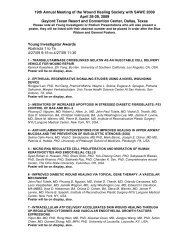

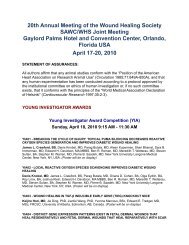
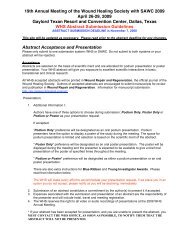
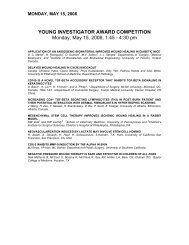



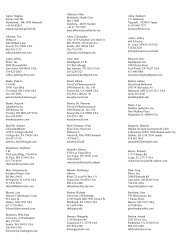
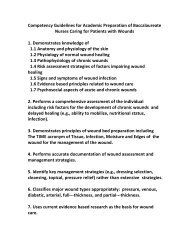
![2010 Abstracts-pah[2] - Wound Healing Society](https://img.yumpu.com/3748463/1/190x245/2010-abstracts-pah2-wound-healing-society.jpg?quality=85)